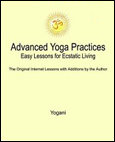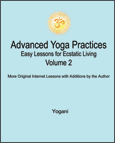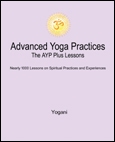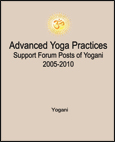|
Public Home | Plus Home | Main Lessons | Tantra Lessons | Public Forum | Plus Forum | Downloads | Books Topic Paths | Search | Training-Retreats | Testimonials | Survey | Interviews | MultiMedia | Contact | Donate |
|
Advanced Yoga Practices Note: For the Original Internet Lessons with additions, see the AYP Easy Lessons Books. For the Expanded and Interactive Internet Lessons, AYP Online Books, Audiobooks and more, see AYP Plus. Lesson 288 - Yoni Spinal Breathing Pranayama - Balancing Energy in the Head (Audio) From: Yogani
Now we will offer the option to take another element of yoni mudra and add it to our spinal breathing pranayama practice. The element of practice
we will use is the gentle nudging of the eyes with the index fingers from
the lower outside corners of the eye sockets inward and upward toward the
point between the eyebrows, or the center brow, as we sometimes call it. See
lesson 91 for the particulars of this aspect of
practice. We don't close the nostrils in this case, or use other aspects of
yoni mudra practice. We just use the finger/eye maneuver and continue with
our spinal breathing practice as originally instructed in lesson 41.
We can continue with whatever other
practices (siddhasana, mudras & bandhas) we have been doing along with our
spinal breathing. Regarding what to do with
the arms while doing the finger/eye maneuver during our spinal breathing
pranayama, the answer is - whatever is comfortable. Some may like to keep
the elbows up, or resting on something. Others may like to let the elbows
hang down to the sides of the torso, or rest easily against the torso.
Whatever works best for us is what we should do. The only criterion is that
we be comfortable so we are not unduly distracted from our spinal breathing
practice. Like with any other practice we add for integration during spinal
breathing (and we have added a bunch), there will likely be a "clunky
period" where things feel a bit strange - new physical positioning, new
energies flowing, etc. We just ease in and not force anything, backing off
if it is too much, and come back to the practice addition as and when we
feel inspired to. We keep it as light and easy as possible. Gentle
persuasion over time is how we develop the habits of effective application
of additions during spinal breathing, and in all of our other practices, as
well. What do we gain from adding the nudging of the eyes during spinal breathing pranayama? Well, several things. First, at our option, we are increasing the time that this element of yoni mudra is applied. If comfortable, we can use it for the full duration of our spinal breathing session, which can be five, ten, or more minutes, depending on what our current practice is, based on what the build-up of our practice has been over time. If it is not comfortable to use the finger/eye maneuver for the full duration of our spinal breathing session, we can discontinue it at any time along the way, and complete our spinal breathing without it. This is how we handle the addition of any practice during spinal breathing - no forcing. Second, if there has been
some ecstatic conductivity rising in the nervous system, the finger/eye
maneuver will tend accentuate it, sometimes dramatically. This happens
because gently nudging the eyes in this way (along with adding a slight
furrow of the center brow via sambhavi mudra) greatly increases stimulation
of the ajna (third eye) area of the brain. This is the neurobiology
extending from the center brow (in front of the pituitary gland) back to the
center of the brain (pineal gland) and down into the medulla oblongata
(brain stem). As we know, the physical positioning of the eyes can have a
dramatic effect on the energy flow in the head. The finger/eye maneuver
increases this effect.
Third, if there have been some energy obstructions in the head, which spinal breathing alone has not been able to dissolve in a timely fashion, adding the finger/eye maneuver can help to dissolve such obstructions and improve the balance of energy flow in the head. Common energy symptoms like pressure at the brow, at the back of the head, or elsewhere in the head, can be relieved by adding the finger/eye maneuver, in moderation. Like with any other practice we discuss, self-pacing is very important in considering adding the finger/eye maneuver to our spinal breathing. We should be well established in our routine of spinal breathing and deep meditation practice, and should also be comfortable with yoni mudra kumbhaka and the other mudras and bandhas, as well. In other words, this new hybrid practice is for those who already have good experience with all of the practices discussed previously in these lessons. What we are doing here is refining our practice to be more effective and efficient. As with all of our practices, our comfort and safety with this new addition will depend primarily on our ability to self-pace what we are doing in relation to resulting experiences. If our current practices are not smooth and stable, we should not take on new practices. On the contrary, if there is roughness in our practices or daily living, we should be self-pacing - reducing practices until our routine has become stable and daily living is reasonably smooth. A question may arise, if we are already doing yoni chin pump, and are now enhancing our spinal breathing to include the finger/eye maneuver, is it still necessary to be doing yoni mudra kumbhaka as a separate practice? This is really the practitioner's call. Yoni mudra kumbhaka may be continued in the established time slot during the overall routine of practices. Or it can be discontinued if both yoni chin pump and yoni spinal breathing are in use. Between these two hybrid practices, all of the elements of yoni mudra are covered - finger/eye maneuver (in spinal breathing) and kumbhaka (breath suspension in chin pump) integrated with siddhasana and the rest of the mudras and bandhas. So it is up to you. For those on the go, there can be a time savings in using the two hybrid practices and not doing yoni mudra kumbhaka as a separate practice. If we choose to save some time by not doing yoni mudra kumbhaka as a separate practice, we can still maintain the time of the elements of yoni mudra by using them in chin pump and spinal breathing. In fact, we can increase the time of finger/eye maneuver by using it in spinal breathing, because, for most of us, spinal breathing is a longer session in our routine than yoni mudra kumbhaka is. On the other hand, those devoted to the practice of yoni mudra kumbhaka should not feel they must streamline their practice with the hybrid methods. In fact, both kinds of practice can be done in a single routine. Just make sure to self-pace as necessary. Adding the hybrid practices while keeping yoni mudra kumbhaka in place will be equivalent to "doubling up" yoni mudra practice. While we'd all like to go as fast as possible along the road to enlightenment, sometimes less will be more in our practice routine. All who have been doing this for a while know this from direct experience. Self-pacing in practices is very important to maintain good progress with comfort. Finally, yoni chin pump and yoni spinal breathing pranayama are not being presented as core practices in AYP, and can be passed by entirely, if need be. In fact, this is true of everything in the lessons. This is a self-directed approach, and the practitioner is always in the driver's seat. Like everything else in the lessons, the hybrid practices are optional enhancements we can use as we may be inspired by our own bhakti (spiritual desire). More refinements and
additions to practices will be offered as we continue to step forward along
the road of applied yoga science.
Wishing you all the best
on your chosen path. Enjoy!
Yoni
Mudra Kumbhaka Related Lessons Topic Path Discuss this Lesson in the AYP Plus Support Forum Note: For detailed instructions on spinal breathing, see the AYP Spinal Breathing Pranayama book. For instructions on mudras and bandhas, see the Asanas, Mudras and Bandas book. Also see AYP Plus. |
|
|
|
Join the Mail List:
AYP Retreats
eBooks - PDF, EPUB
FREE eBooks with
SAVE with Bundled
|

























